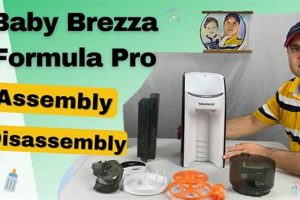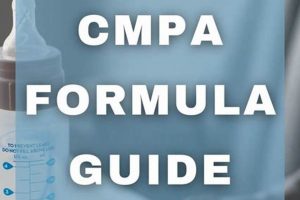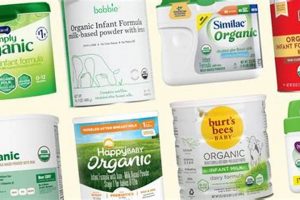Plant-based infant nutrition products represent a specialized category of food designed to provide complete nourishment for infants following a dietary restriction that excludes all animal-derived ingredients. These products aim to replicate the nutritional profile of breast milk and conventional infant formulas, utilizing ingredients such as soy, rice, or pea protein isolates to meet the specific developmental needs of infants. Such alternatives cater to families with ethical, religious, or medical motivations for avoiding animal products in their children’s diets.
The significance of plant-derived nourishment for infants lies in its ability to offer a nutritionally sound alternative for those who cannot or choose not to consume traditional formulas. This approach ensures that infants receive essential nutrients, including proteins, fats, carbohydrates, vitamins, and minerals, vital for healthy growth and development. Historically, the development of these products has been driven by increasing awareness of dietary choices and a desire to provide suitable options for diverse family values and potential allergies related to cow’s milk-based formulas.
The following sections will delve into the specific composition of these plant-based options, exploring the ingredients utilized, their nutritional adequacy, relevant safety considerations, and a comparison against conventional formulas, offering a comprehensive understanding of this evolving field in infant nutrition.
Guidance on Plant-Based Infant Nutrition
The following information offers practical guidance regarding the selection and utilization of plant-based infant nutrition products, emphasizing considerations for infant health and well-being.
Tip 1: Consult with a Healthcare Professional: Prior to introducing a plant-based formula, seek advice from a pediatrician or registered dietitian. Professional guidance ensures the chosen product aligns with the infant’s specific nutritional requirements and addresses potential allergies or sensitivities.
Tip 2: Review Ingredient Lists Carefully: Examine the formula’s composition to verify the presence of essential nutrients such as iron, calcium, vitamin D, and vitamin B12. Ensure the ingredients are sourced from reputable suppliers and are free from potentially harmful additives.
Tip 3: Follow Preparation Instructions Precisely: Adhere strictly to the manufacturer’s instructions for mixing and preparing the formula. Incorrect preparation can compromise the formula’s nutritional value and potentially introduce contaminants.
Tip 4: Monitor Infant Growth and Development: Regularly monitor the infant’s growth, weight gain, and overall development. Any concerns or deviations from expected milestones should be promptly reported to a healthcare professional.
Tip 5: Be Aware of Potential Allergies: Observe the infant for signs of allergic reactions, such as skin rashes, digestive upset, or respiratory difficulties. Soy, often used in plant-based formulas, is a common allergen; alternative protein sources should be considered if sensitivities arise.
Tip 6: Prioritize Iron-Fortified Options: Select plant-based formulas that are fortified with iron. Iron deficiency is a common concern in infants, and adequate iron intake is crucial for cognitive development and overall health.
Tip 7: Consider Hydrolyzed Protein Formulas: For infants with sensitivities or allergies, explore hydrolyzed protein formulas. Hydrolyzing the protein breaks it down into smaller, more easily digestible components, reducing the likelihood of adverse reactions.
Adherence to these guidelines can facilitate the safe and effective utilization of plant-based infant nutrition products, promoting optimal health and development for infants.
The subsequent sections will further explore specific aspects of formulation, regulatory standards, and long-term considerations associated with plant-based infant nutrition.
1. Plant-based protein sources
Plant-based protein sources form the foundational component of infant formulas designed to exclude animal-derived ingredients. The selection of these sources directly impacts the formula’s nutritional adequacy and its ability to support infant growth and development. For example, soy protein isolate is a commonly used source due to its relatively complete amino acid profile and established safety record. Rice protein and pea protein isolates represent alternative sources increasingly employed to address soy allergies or sensitivities. The amino acid composition, digestibility, and bioavailability of these protein sources must be carefully evaluated to ensure they meet the specific needs of infants. The adequacy of these protein sources is ensured by adding L-Carnitine and taurine to the recipe, to fulfill the growing baby needs.
The choice of plant-based protein extends beyond mere protein content; it influences the overall nutrient profile of the formula. Different protein sources contain varying levels of micronutrients and phytochemicals, which can interact with other components in the formula. For instance, soy contains phytoestrogens, which have been a subject of ongoing research regarding their potential long-term effects. The processing methods used to isolate and purify these proteins also play a crucial role. Excessive heat treatment can denature proteins, reducing their digestibility and nutritional value. Furthermore, the presence of anti-nutritional factors, such as phytates, in some plant-based sources can interfere with mineral absorption, necessitating careful processing to minimize their impact. The sources must also be selected to ensure that the final product is free from harmful materials and contamination that may be found in the nature.
In summary, the selection and processing of plant-based protein sources are critical determinants of the nutritional quality and safety of plant-based infant formulas. Thorough assessment of amino acid profiles, digestibility, potential allergens, and processing methods is essential to ensure that these formulas can effectively support the healthy growth and development of infants. Further research and regulatory oversight are necessary to continuously refine and improve the formulation of plant-based infant formulas and provide parents with safe and nutritious options.
2. Nutritional adequacy evaluation
Nutritional adequacy evaluation forms a critical component in the development and regulation of plant-based infant formulas. The exclusion of animal-derived ingredients necessitates rigorous assessment to ensure that these formulas meet the comprehensive nutritional needs of infants, typically fulfilled by breast milk or conventional formulas. This evaluation entails a detailed analysis of macronutrient composition (protein, fat, carbohydrates), micronutrient content (vitamins, minerals), and the bioavailability of these nutrients. The evaluation process is pivotal to determine if the plant-based formula can support optimal growth, development, and overall health in infants.
The importance of nutritional adequacy evaluation is underscored by the potential consequences of nutrient deficiencies during infancy. Deficiencies in essential nutrients such as iron, vitamin B12, vitamin D, calcium, and zinc can lead to impaired cognitive development, weakened immune function, and compromised bone health. For instance, iron deficiency anemia can hinder brain development and motor skills. The evaluation process involves comparing the nutrient profile of the plant-based formula against established reference standards, such as those provided by regulatory bodies like the World Health Organization (WHO) and the European Food Safety Authority (EFSA). These standards outline the minimum and maximum levels of essential nutrients required for infant formulas. For example, LCPUFA, particularly DHA and ARA, are essential nutrients that requires a very precise measure to be considered safe for infants.
In conclusion, thorough nutritional adequacy evaluation is essential for plant-based infant formulas. This process ensures that these products provide the comprehensive and balanced nutrition necessary for supporting optimal infant health and development. Continuous monitoring, refinement of evaluation methods, and adherence to regulatory standards are critical to ensure that plant-based formulas remain a safe and nutritious option for infants. A continuous cooperation between the manufacturers, nutritionist and pediatricians is a must to guarantee a safe and efficient development of plant-based infant formulas.
3. Iron and vitamin fortification
Iron and vitamin fortification represents a critical aspect of vegan infant formula development, necessitated by the inherent differences in nutrient bioavailability and composition between plant-based ingredients and breast milk or conventional, animal-derived formulas. This process aims to bridge nutritional gaps and ensure that infants receive the essential micronutrients required for optimal growth and cognitive development.
- Iron Bioavailability Enhancement
Iron from plant sources is generally less bioavailable than iron from animal sources. Phytates, naturally occurring compounds in plant-based ingredients, can inhibit iron absorption. Fortification with highly bioavailable forms of iron, such as ferrous bisglycinate, is essential to mitigate this issue. Additionally, strategies to reduce phytate content through processing techniques are crucial to maximize iron absorption in vegan formulas.
- Vitamin B12 Supplementation
Vitamin B12 is primarily found in animal products, making it virtually absent in plant-based diets. Infants require adequate vitamin B12 for neurological development and red blood cell formation. Vegan formulas must be fortified with a bioavailable form of vitamin B12, such as cyanocobalamin or methylcobalamin, to prevent deficiency and ensure healthy growth.
- Vitamin D Enrichment
Vitamin D is crucial for calcium absorption and bone health. While infants can synthesize vitamin D through sun exposure, this process is often insufficient, particularly in regions with limited sunlight or in infants with darker skin pigmentation. Vegan formulas should be fortified with vitamin D2 (ergocalciferol), a plant-derived form of vitamin D, to support bone development and overall health.
- Calcium and Zinc Optimization
While plant-based ingredients may contain calcium and zinc, their bioavailability can be affected by the presence of phytates and other compounds. Fortification and processing techniques aimed at enhancing bioavailability are essential to ensure that infants receive adequate amounts of these minerals for bone development, immune function, and overall growth.
The careful consideration and implementation of iron and vitamin fortification strategies are paramount in the formulation of nutritionally adequate vegan infant formulas. These strategies address the inherent limitations of plant-based diets in providing essential micronutrients, ensuring that infants receive the necessary building blocks for healthy growth and development. Continuous monitoring and refinement of fortification practices, guided by scientific research and regulatory standards, are essential to optimize the nutritional profile of vegan infant formulas.
4. Allergen awareness
Allergen awareness is of paramount importance in the context of vegan infant formula, given that these formulas often rely on plant-based protein sources known to be allergenic. Careful consideration of potential allergens and rigorous manufacturing practices are essential to minimize the risk of adverse reactions in infants.
- Soy Protein Allergy
Soy protein isolate is frequently used in vegan infant formulas due to its relatively complete amino acid profile. However, soy is a common allergen, and infants with soy allergies may experience symptoms ranging from mild skin rashes to severe anaphylactic reactions. Parents and caregivers must be vigilant in monitoring infants for signs of soy allergy when introducing a soy-based formula. Alternative protein sources should be considered for infants with known or suspected soy allergies.
- Rice Protein Concerns
Rice protein, while generally considered hypoallergenic, can pose a risk of arsenic contamination. Rice plants can absorb arsenic from soil and water, and elevated levels of arsenic in infant formula can have detrimental health effects. Manufacturers must implement rigorous testing protocols to ensure that rice protein used in vegan infant formulas meets strict safety standards for arsenic levels.
- Pea Protein Sensitivities
Pea protein is an increasingly popular alternative in vegan infant formulas, offering a relatively hypoallergenic option for infants with soy allergies. However, some infants may still exhibit sensitivities to pea protein, manifesting as digestive upset or skin reactions. Careful observation and monitoring are essential when introducing a pea protein-based formula.
- Cross-Contamination Risks
Vegan infant formulas are often manufactured in facilities that also process other allergenic ingredients, such as dairy, eggs, and nuts. Cross-contamination can occur if proper cleaning and sanitation protocols are not followed, posing a risk to infants with severe allergies. Manufacturers must implement stringent allergen control measures to minimize the risk of cross-contamination and ensure the safety of their products.
Effective allergen awareness practices, including careful ingredient selection, rigorous testing, and stringent manufacturing controls, are essential to minimize the risk of allergic reactions in infants consuming vegan infant formulas. Parents and caregivers must be educated about the potential allergens in these formulas and the importance of monitoring infants for signs of adverse reactions. Collaboration between manufacturers, healthcare professionals, and regulatory agencies is crucial to ensure the safety and well-being of infants relying on vegan infant formulas.
5. Digestibility assessment
Digestibility assessment plays a crucial role in the development and evaluation of plant-based infant formulas. Given that infants possess immature digestive systems, the efficient breakdown and absorption of nutrients from these formulas are paramount. The assessment process aims to determine how well infants can tolerate and utilize the plant-based ingredients, ensuring that the formula supports adequate growth and development without causing adverse gastrointestinal effects.
- Protein Digestibility and Amino Acid Availability
Plant-based proteins, such as soy, rice, and pea isolates, differ in their digestibility compared to animal-derived proteins found in conventional formulas. Digestibility assessment involves evaluating the extent to which these proteins are broken down into absorbable amino acids within the infant’s digestive tract. Factors such as protein structure, processing methods, and the presence of antinutritional factors can influence protein digestibility. For example, heat treatment during formula processing can denature proteins, potentially improving their digestibility. However, excessive heat can also reduce the bioavailability of certain amino acids. Therefore, precise assessment is necessary to optimize protein processing and ensure adequate amino acid availability for infant growth.
- Carbohydrate Digestibility and Tolerance
Plant-based infant formulas often contain carbohydrates derived from sources such as corn syrup solids, maltodextrin, or sucrose. Digestibility assessment focuses on evaluating how well infants tolerate and metabolize these carbohydrates. Some infants may experience gastrointestinal distress, such as gas, bloating, or diarrhea, if they are unable to efficiently digest certain carbohydrates. The assessment process may involve measuring the levels of undigested carbohydrates in stool samples to identify potential issues. The choice of carbohydrate source and its concentration in the formula must be carefully considered to minimize the risk of digestive upset.
- Fat Digestibility and Absorption
The fat composition of plant-based infant formulas is critical for providing essential fatty acids and supporting overall energy needs. Digestibility assessment focuses on evaluating the efficiency with which infants can absorb and utilize these fats. Plant-based formulas typically contain a blend of vegetable oils, such as soy oil, sunflower oil, and coconut oil. The assessment process involves measuring fat absorption rates and monitoring for signs of fat malabsorption, such as steatorrhea (excess fat in the stool). The ratio of different fatty acids, such as omega-3 and omega-6 fatty acids, also influences fat digestibility and must be carefully balanced to promote optimal infant health.
- Impact of Fiber and Other Components
Plant-based infant formulas may contain fiber, prebiotics, or other non-digestible components that can influence digestibility and gut health. While fiber can promote healthy bowel movements, excessive amounts can lead to digestive discomfort in infants. Digestibility assessment involves evaluating the impact of these components on gut microbiota composition, stool consistency, and overall gastrointestinal tolerance. The optimal amount and type of fiber or prebiotics must be carefully determined to balance the potential benefits with the risk of adverse effects.
In conclusion, digestibility assessment is an indispensable aspect of developing safe and effective vegan infant formulas. Rigorous evaluation of protein, carbohydrate, and fat digestibility, as well as the impact of other components, is necessary to ensure that these formulas support optimal infant growth and development without causing adverse gastrointestinal effects. Continuous monitoring, refinement of assessment methods, and collaboration between manufacturers, healthcare professionals, and regulatory agencies are essential to optimize the digestibility and tolerability of vegan infant formulas.
6. Growth monitoring
Growth monitoring constitutes an indispensable component of infant care, especially when plant-based formulas are utilized. The exclusion of animal products introduces specific nutritional considerations, necessitating careful tracking of an infant’s growth trajectory to ensure adequacy of the chosen formula. Growth monitoring typically involves regular measurements of weight, length/height, and head circumference, plotted on standardized growth charts developed by organizations such as the World Health Organization (WHO) or the Centers for Disease Control and Prevention (CDC). These charts provide a reference range against which an individual infant’s growth can be compared, identifying potential deviations from expected patterns. A key example is the observation of stunted growth despite adequate caloric intake, which might indicate inadequate protein digestion or absorption from the plant-based source, thus signaling a need for formula adjustments or further medical evaluation.
The practical significance of growth monitoring extends beyond simply tracking numerical data. It enables healthcare providers to assess the overall well-being of the infant, identify potential nutrient deficiencies, and intervene promptly to correct imbalances. For instance, consistently low weight gain, coupled with signs of fatigue or developmental delays, might suggest an iron deficiency, requiring supplementation or a change in formula with higher iron content. Likewise, inadequate linear growth can indicate a lack of essential amino acids or other nutrients crucial for bone development, prompting a reevaluation of the formula’s composition or the introduction of complementary foods. In cases where the plant-based formula relies on a less common protein source, such as rice or pea protein, growth monitoring provides critical feedback on the infant’s tolerance and utilization of that specific protein.
In summary, growth monitoring is not merely a routine practice but a vital safeguard for infants receiving plant-based formulas. It provides the necessary data to evaluate the nutritional adequacy of the chosen formula, detect potential deficiencies or intolerances, and guide timely interventions to ensure optimal growth and development. Challenges may arise in accurately interpreting growth data due to individual variations or the absence of specific growth charts tailored to infants exclusively fed plant-based formulas. However, consistent and careful monitoring, coupled with expert guidance from healthcare professionals, remains the cornerstone of ensuring positive outcomes for infants on plant-based diets.
7. Regulatory compliance
Regulatory compliance constitutes a foundational element in the production and marketing of vegan infant formula. Stringent regulations govern the composition, manufacturing processes, and labeling of infant formulas to ensure they meet specific nutritional and safety standards. These regulations, established by governing bodies such as the Food and Drug Administration (FDA) in the United States and the European Food Safety Authority (EFSA) in Europe, are designed to protect the health and well-being of infants, a particularly vulnerable population. Non-compliance with these regulations can result in serious consequences, including product recalls, legal penalties, and, most importantly, potential harm to infants due to nutritional deficiencies or the presence of harmful contaminants. For instance, the regulations specify minimum and maximum levels of essential nutrients, such as vitamins, minerals, and amino acids, that must be present in infant formula. These requirements are based on scientific evidence regarding the nutritional needs of infants at different stages of development. The regulations also mandate testing for contaminants, such as heavy metals and pathogenic bacteria, to ensure product safety.
The specific challenges associated with regulatory compliance for vegan infant formulas stem from the need to meet these stringent nutritional requirements using plant-based ingredients. Unlike cow’s milk-based formulas, vegan formulas rely on plant protein sources, such as soy, rice, or pea protein, which may have different amino acid profiles and bioavailability of nutrients. Meeting the regulatory requirements for essential amino acids, vitamins, and minerals often necessitates fortification with synthetic or isolated nutrients. Manufacturers must demonstrate that these fortified nutrients are bioavailable and effectively utilized by infants. Furthermore, regulatory scrutiny extends to the sourcing and processing of plant-based ingredients to minimize the risk of allergens and contaminants. For example, soy-based formulas must be carefully processed to reduce the presence of phytoestrogens, while rice-based formulas must be tested for arsenic levels. Failure to adequately address these challenges can lead to regulatory non-compliance and jeopardize the market viability of the product.
In summary, regulatory compliance is an indispensable aspect of the vegan infant formula industry. It ensures that these products meet the rigorous nutritional and safety standards necessary to support infant health and development. The challenges associated with meeting these standards using plant-based ingredients require meticulous formulation, sourcing, and manufacturing practices. Manufacturers must remain vigilant in adhering to evolving regulatory requirements and invest in research and development to optimize the nutritional profile and safety of their products. A proactive approach to regulatory compliance is not only essential for protecting infants but also for maintaining consumer trust and fostering the long-term sustainability of the vegan infant formula market.
Frequently Asked Questions Regarding Vegan Infant Formula
The following questions address common concerns and misconceptions surrounding the utilization of vegan infant formula, providing evidence-based information to promote informed decision-making.
Question 1: Is vegan infant formula nutritionally complete for infant development?
Vegan infant formulas, when formulated in accordance with established regulatory guidelines, can provide complete nutrition for infants. These formulas are fortified with essential nutrients, including iron, vitamin B12, and vitamin D, which are often lacking in plant-based diets. However, careful selection and monitoring are crucial to ensure the infant’s nutritional needs are adequately met.
Question 2: What are the primary protein sources in vegan infant formula, and are they adequate?
Common protein sources include soy protein isolate, rice protein, and pea protein. These sources must undergo thorough evaluation to ensure they provide a complete amino acid profile comparable to breast milk or conventional formulas. Fortification with specific amino acids may be necessary to meet infant nutritional requirements.
Question 3: Are there potential allergenic concerns associated with vegan infant formula?
Yes, soy-based formulas can pose allergenic risks for infants with soy allergies. Alternative protein sources, such as rice or pea protein, may be considered. However, careful monitoring for allergic reactions is essential, regardless of the protein source utilized.
Question 4: How is iron bioavailability addressed in vegan infant formula?
Iron from plant sources is generally less bioavailable than iron from animal sources. Vegan formulas are typically fortified with highly bioavailable forms of iron, such as ferrous bisglycinate, to enhance absorption. Strategies to reduce phytate content, which can inhibit iron absorption, are also employed.
Question 5: What regulatory standards govern the production and marketing of vegan infant formula?
Vegan infant formulas are subject to the same stringent regulatory standards as conventional formulas. These standards, established by governing bodies like the FDA and EFSA, dictate the composition, manufacturing processes, and labeling requirements to ensure product safety and nutritional adequacy.
Question 6: How does one monitor the growth and development of an infant consuming vegan infant formula?
Regular growth monitoring, including measurements of weight, length, and head circumference, is essential to ensure the infant is growing and developing appropriately. Healthcare professionals should be consulted to interpret growth data and address any potential concerns.
The informed selection and utilization of plant-based infant nutrition products, coupled with diligent monitoring and adherence to healthcare professional guidance, can facilitate optimal health and development for infants.
The subsequent sections will explore further considerations related to the long-term health implications and ongoing research in the field of plant-based infant nutrition.
Conclusion
This exploration of vegan baby formula has illuminated critical aspects of its formulation, nutritional adequacy, and regulatory oversight. The necessity for careful ingredient selection, rigorous testing for allergens and contaminants, and fortification with essential micronutrients is paramount. Growth monitoring and adherence to established guidelines remain essential for ensuring infant well-being.
The informed utilization of plant-based infant nutrition necessitates ongoing research, stringent regulatory enforcement, and collaborative efforts among manufacturers, healthcare professionals, and parents. This commitment is crucial to optimizing the safety and efficacy of these products, thereby supporting the healthy development of infants relying on vegan baby formula.







